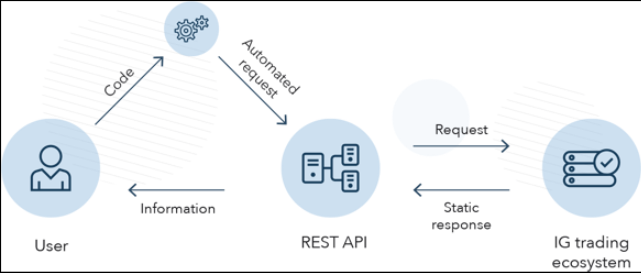
Representational State Transfer (REST) is an architectural style that defines a set of constraints to be used for creating web services.In other words, it is an interface that two computer machines use to exchange information securely over the internet. The REST API is a simple and flexible method of accessing web-based resources without any processing.

Resources must be understood in order to comprehend how REST APIs operate. A resource can be any piece of information that can be named, including a document, an image, a group of other resources and more. When two components interact, REST uses a resource identifier to identify the precise resource that is involved.
The kind of request you make of the server is determined by the method. The following five primary resource methods are related to REST APIs:
⚫ GET: Using this method, server is able to find the data you requested and sends it back to you.
⚫ PUT: This operation replaces an existing instance of a resource with the resource specified in the request body.
⚫ POST: Using this method, the server is able to add a new data entry.
⚫ DELETE: Using this method, the server is able to delete a new data entry.
⚫ PATCH This method in HTTP allows us for making partial changes to an existing resource

REST is preferable to SOAP for several reasons. Below are few advantages that REST APIs have:
✅ Scalability: The product can be easily scaled by development teams due to the separation of the client and server.
✅ Flexibility and Portability: It is possible to perform a server migration because REST-style APIs need data from one of the requests to be sent properly. There is always possibility to carry out changes on the database at any time.
✅ Independence: With the separation between client and server, the protocol makes it easier for developments across a project to take place independently. REST APIs can be customised to the platform and working syntax, giving developers the chance to test various environments concurrently while they are developing.
✅ Lightweight: REST APIs are quick and efficient because they make use of the HTTP standard, which supports a variety of file types, including JSON, XML, and HTML. It is perfect for a variety of projects, including IoT devices and mobile app development.
People who use REST APIs will face some difficulties in addition to design and architectural limitations. These difficulties could include:
No matter how you format your URLs, it's important to be consistent throughout your API. Unfortunately, as operations become more intricate, the number of combinations grows even more. Consistency can therefore be challenging to achieve in large codebases with numerous developers.
The practise of creating multiple versions of an API allows for changes or updates to be made without upsetting users. Versioning is frequently used for APIs to avoid compatibility problems. However, because multiple APIs must be maintained, outdated endpoints continue to function.
Depending on the situation in which it is used, API authentication will change. Some applications from third parties are regarded as logged-in users with particular rights and permissions.
Registered users can use other third-party applications where they can only access their data, like looking for emails or documents. Up to 20 different authorization methods might be in use, which makes it much more difficult to ever make your first API call. When there is so much resistance right away, developers occasionally give up
Security problems can still occur even though RESTful APIs offer a simpler way to access and manipulate your application. For instance, a client could overload your server with thousands of requests per second. Other security issues with REST APIs include:
With 450 million active users each month, Twitter dominates the social media space. The Twitter API gives programmers a way to incorporate Twitter's features and advertise their applications on the site.
By utilising Twitter's identification system, developers can use the Twitter API to speed up the registration process. The API also enables efficient marketing using Twitter's data and the display of tweets to users based on factors like location or popular hashtags.

We can submit trade orders, open positions, close positions, and view market sentiment using the Instagram Markets REST API. As a result, programmers can create apps that incorporate Instagram user data into their own creations.

The Salesforce REST API is the perfect API for creating mobile applications or external clients because it enables integration with Salesforce applications using straightforward HTTP methods in either JSON or XML formats. Additionally, Salesforce supports Apex REST, allowing you to use Apex to build Web services on Force.com.
